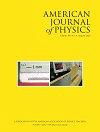数据时代的热物理学--学生判断等分定理的适用性
IF 0.9
4区 教育学
Q3 EDUCATION, SCIENTIFIC DISCIPLINES
引用次数: 0
摘要
向热物理学入门课程的学生提供许多低密度气体的热容量随温度变化的曲线图,可以让他们寻找系统趋势。具体来说,大量的热容量数据不仅能让学生发现等分定理,还能指出其有限的适用性。提供了下载和绘制随温度变化的热容量数据的计算机代码。本文章由计算机程序翻译,如有差异,请以英文原文为准。
Thermal physics in the data age—Students judge the applicability of the equipartition theorem
Providing students of introductory thermal physics with a plot of the heat capacities of many low density gases as a function of temperature allows them to look for systematic trends. Specifically, large amounts of heat capacity data not only allow students to discover the equipartition theorem but also point to its limited applicability. Computer code to download and plot the temperature-dependent heat capacity data is provided.
求助全文
通过发布文献求助,成功后即可免费获取论文全文。
去求助
来源期刊

American Journal of Physics
物理-物理:综合
CiteScore
1.80
自引率
11.10%
发文量
146
审稿时长
3 months
期刊介绍:
The mission of the American Journal of Physics (AJP) is to publish articles on the educational and cultural aspects of physics that are useful, interesting, and accessible to a diverse audience of physics students, educators, and researchers. Our audience generally reads outside their specialties to broaden their understanding of physics and to expand and enhance their pedagogical toolkits at the undergraduate and graduate levels.
 求助内容:
求助内容: 应助结果提醒方式:
应助结果提醒方式:


